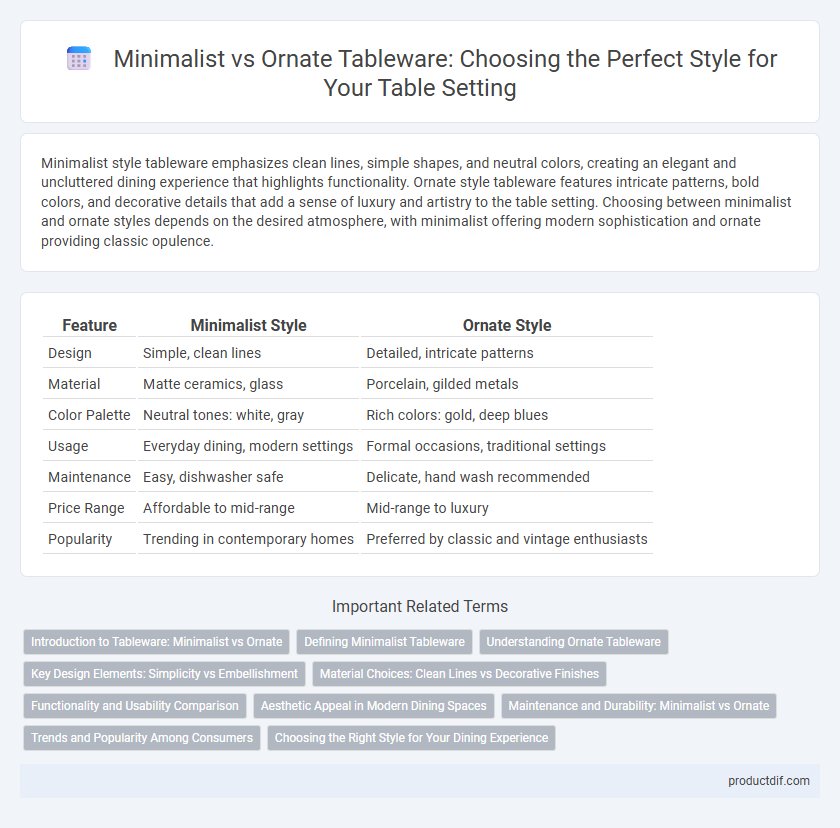Minimalist style tableware emphasizes clean lines, simple shapes, and neutral colors, creating an elegant and uncluttered dining experience that highlights functionality. Ornate style tableware features intricate patterns, bold colors, and decorative details that add a sense of luxury and artistry to the table setting. Choosing between minimalist and ornate styles depends on the desired atmosphere, with minimalist offering modern sophistication and ornate providing classic opulence.
Table of Comparison
| Feature | Minimalist Style | Ornate Style |
|---|---|---|
| Design | Simple, clean lines | Detailed, intricate patterns |
| Material | Matte ceramics, glass | Porcelain, gilded metals |
| Color Palette | Neutral tones: white, gray | Rich colors: gold, deep blues |
| Usage | Everyday dining, modern settings | Formal occasions, traditional settings |
| Maintenance | Easy, dishwasher safe | Delicate, hand wash recommended |
| Price Range | Affordable to mid-range | Mid-range to luxury |
| Popularity | Trending in contemporary homes | Preferred by classic and vintage enthusiasts |
Introduction to Tableware: Minimalist vs Ornate
Minimalist tableware emphasizes sleek lines, neutral colors, and functional design, creating a clean and modern dining experience that highlights simplicity and elegance. Ornate tableware showcases intricate patterns, vibrant colors, and detailed craftsmanship, reflecting luxury and traditional aesthetics that enhance visual richness. Both styles influence dining atmosphere and presentation, catering to diverse tastes and cultural preferences.
Defining Minimalist Tableware
Minimalist tableware emphasizes clean lines, simple forms, and neutral colors, creating an understated elegance that prioritizes function over decoration. This style often features materials like matte ceramic, clear glass, and stainless steel, enhancing the visual calmness and versatility on the dining table. Minimalist designs suit modern interiors by promoting a clutter-free aesthetic and highlighting the food as the focal point.
Understanding Ornate Tableware
Ornate tableware features intricate designs, elaborate patterns, and rich textures that emphasize luxury and craftsmanship. Materials like fine porcelain, detailed metalwork, and hand-painted elements are common, highlighting decorative artistry over simplicity. This style enhances formal dining experiences by creating a visually stunning table setting that conveys elegance and tradition.
Key Design Elements: Simplicity vs Embellishment
Minimalist style tableware emphasizes clean lines, neutral colors, and unadorned surfaces, prioritizing functionality and understated elegance. Ornate style features intricate patterns, bold decorations, and elaborate textures, creating visual richness and artistic expression. The contrast between simplicity and embellishment defines the core design philosophy distinguishing these two tableware aesthetics.
Material Choices: Clean Lines vs Decorative Finishes
Minimalist style tableware emphasizes materials like matte porcelain and brushed stainless steel, featuring clean lines and smooth surfaces that highlight simplicity and functionality. Ornate style favors materials such as hand-painted ceramics, embossed glass, and silver-plated finishes, enriched with intricate patterns and decorative details that create a luxurious and elaborate appearance. Material choices in minimalist designs support a sleek, uncluttered aesthetic, while ornate styles prioritize embellishments that enhance visual richness and texture.
Functionality and Usability Comparison
Minimalist tableware emphasizes clean lines and simplicity, enhancing functionality through ease of use and effortless cleaning. Ornate styles, while visually striking with intricate designs, may compromise usability due to delicate features and more complex maintenance requirements. Choosing between these styles depends on the balance between aesthetic preference and practical daily use needs.
Aesthetic Appeal in Modern Dining Spaces
Minimalist style tableware emphasizes clean lines, neutral colors, and simple forms, creating a sleek and calming aesthetic that complements modern dining spaces. Ornate style tableware features intricate patterns, bold colors, and detailed embellishments, adding a sense of luxury and artistic expression to table settings. Both styles enhance aesthetic appeal but cater to different design sensibilities, with minimalist fostering understated elegance and ornate promoting visual richness.
Maintenance and Durability: Minimalist vs Ornate
Minimalist tableware typically features smooth surfaces and simple designs that resist staining and chipping, making maintenance easier and enhancing durability. Ornate tableware, with intricate patterns and raised details, requires more careful cleaning to preserve its embellishments and is often more prone to damage. The choice between minimalist and ornate styles impacts the longevity of your pieces and the effort needed to maintain their aesthetic appeal.
Trends and Popularity Among Consumers
Minimalist style tableware is trending due to its clean lines, muted colors, and versatility in modern dining settings, favored by consumers seeking simplicity and functionality. Ornate style tableware, characterized by intricate patterns and bold designs, remains popular among those valuing tradition and decorative elegance in formal occasions. Current market data shows a growing preference for minimalist designs in urban areas, while ornate styles retain strong appeal in luxury and heritage segments.
Choosing the Right Style for Your Dining Experience
Selecting the right tableware style significantly impacts the ambiance and functionality of your dining experience. Minimalist style, characterized by clean lines and neutral tones, emphasizes simplicity and modern elegance, ideal for daily use and contemporary settings. Ornate style features intricate designs and rich detailing, enhancing formal occasions with a luxurious and traditional atmosphere.
Minimalist Style vs Ornate Style Infographic

 productdif.com
productdif.com